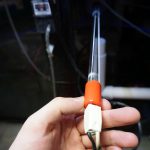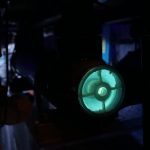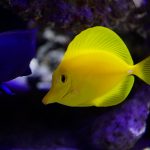UV Sterilizers as Part of a Healthy Aquarium Setup in Your Home or Business
Ultraviolet sterilizers may initially seem like an obscure and unnecessary life support component to add to your tropical freshwater or saltwater aquarium but they can solve a lot of problems. Along with regular fish tank maintenance, good water quality, and good feeding habits, UV sterilizers can also help prevent disease outbreaks like marine or freshwater Ich, “velvet” diseases, protozoan outbreaks and other pathogens that affect the health of your system and animals. For a more detailed explanation of how these life support components work, please speak with one of our professional Portland aquarists but here is a comprehensive overview:
How UV Sterilizers Work in Your Fish Tank
When plumbed properly into a life support system, the ultraviolet radiation from the lamp inside your sterilizer irradiates your aquarium water as it travels through the vessel. The wavelength of the UV emitted by the lamp targets the bonds in the genetic material of algae, protozoans, bacteria, and other pathogens, disrupting this material and preventing these organisms from multiplying. The wavelengths of germicidal radiation (approx. 200-280 nanometers) are below our ability to discern them but they can cause damage to our vision if viewed directly. The ends of most sterilizer vessels have translucent filters that allow us to confirm that the lamps are working but prevent this light from escaping the unit.
There are a number of factors that affect the efficiency of a UV sterilizer, such as:
- The Wattage of the Lamp – The common wattages for UV lamps in hobbyists’ systems are 25, 40 and 65. There are higher wattage lamps available but they tend to used more on professional life support systems or on the much larger (1,000 or more gallons) aquariums in Portland-area homes and businesses.
- The Age of the Lamp – Much like a fluorescent bulb, the output from UV lamps degrades over time. The effective germicidal life of a lamp varies between 2,500 and 9,000 hours (approx. 4 months to one year) but most manufacturers recommend replacement every six months for best results.
- The Contact Time – Contact time, also called “dwell time,” is the amount of time a given volume of water is exposed to the UV radiation. If water is pumped too rapidly through the vessel, very little irradiation occurs and the sterilizer provides little help to the health of the system and animals. When a sterilizer is properly plumbed into a system, the valves on either end of the unit control the contact time. Your professional PDX-area aquarist can provide insight on proper plumbing and valve configuration.
- The Distance Between the Lamp and Organism – The optimal distance between UV lamp and pathogen is around 1 inch. Since most hobbyist sterilizers are 2 or 3 inches in diameter with the lamp located right down the middle, this distance is just about right for optimal effect. Pathogens that travel outside this 1-inch range receive less than ideal irradiation but chances are good that they will become increasingly incapacitated each time they travel through the sterilizer.
- The Type of Pathogen – Viruses and protozoans tend to need higher contact times to become fully irradiated but with proper proactive maintenance and good turnover rates on your system, this becomes less of a concern.
- The Turbidity of the Water – UV radiation cannot travel as far or be nearly as effective in cloudy water but since bacterial or algal blooms cause most cloudy water, sterilizers can help clarify turbid water over time and keep it clear.
Professional Portland, Oregon, Aquarium Advice about UV Sterilizers and Much More
UV sterilizers are not essential life support components for your system but if you don’t have one and your animals suffer from a disease outbreak, you will likely wish you had one to help prevent this from happening again. There’s a lot more to know about sterilizers, such as how to size one properly for your system, how to install them, or how to handle them when replacing lamps or cleaning the quartz sleeve protecting the lamp but our aquarists are always happy to help. For professional PDX-area aquarium advice about sterilizers or any other life support component, just give us a call at 503.784.4403 and schedule a consultation.








